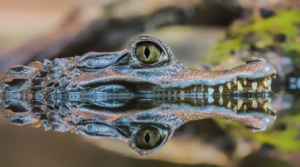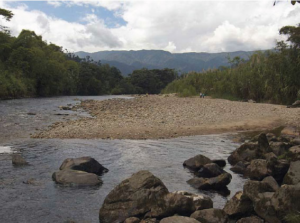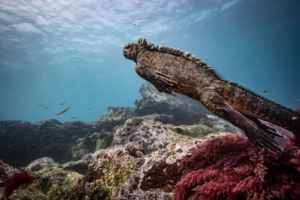The El Angel ecological reserve is nationally recognized because it has an extraordinary biodiversity of moorlands. The frailejones, composite, shrubby plants, characterized by their large leaves, can reach 7 m in height. It is one of the two endemic frailejones páramo ecosystems protected in the country, making it one of Ecuador’s biodiversity hotspots.
Frailejones are important elements in páramo ecosystems where trees do not grow, because in addition to being a food source for birds such as hummingbirds, they help protect the soil and are the regulators of water systems by capturing and retaining water.
Frailejones inhabit the páramo: a cold, humid, rainy and sometimes foggy ecosystem, located in the pyramid of thermal floors between the glaciers and the high Andean forest, between 3,000 and 3,800 meters above sea level. It is a territory catalogued as the most biodiverse high mountain ecosystem in the world.
Although, in a broad sense, there are paramos in all the continents of the tropical zone, it is only possible to find frailejones in the paramos of Venezuela, Colombia and the north of Ecuador.
Frailejones can live for hundreds of years. Although it is said that they only grow one centimeter a year, the truth is that they can grow from one to four centimeters a year, depending on the species. Varela says that there is a frailejón in El Cocuy National Natural Park that can grow up to eight centimeters a year. “According to several investigations where the growth rate of one centimeter per year is related and the height is calculated, a frailejón can reach several hundred years old”, says the biologist.
This sub-tribe of plants plays a key role in sustaining the páramo ecosystem and in providing ecosystem services; they contribute to water regulation in the páramo and prevent soil erosion. They are among the main responsible for water capture and regulation.
Both páramos and frailejones are key to mitigating the climate crisis, helping to capture carbon and regulate the global warming process. They are also fundamental in the supply of water for human consumption; 70% of the water we consume and the water used for the productivity of the Andean cities of the country is taken from their catchment.
Frailejones collect water through the “hairs” they have on their leaves, capture water from rain, fog and air, store it in their bodies and then release it to the ground through their roots.
They have been at serious risk for some time now, precisely because of the climate crisis. At the 2002 World Páramo Congress, it was pointed out that the páramos are a very fragile ecosystem because the flora and fauna that compose them have had to adapt to extreme conditions. These changes could reduce the páramo fringe due to the increase in temperature.
The frailejon is in danger of extinction, mining, the degradation of ecosystems by human activities such as agriculture and cattle ranching, forest fires, climate change (especially due to increased temperatures or changes in precipitation that generate extreme droughts), mega-constructions in the páramos and unsustainable tourism. “And if we add up all the threats, it is very difficult to protect them,” says Varela.
On the other hand, some research has found larvae, beetles and fungi in the frailejones that cause serious damage, even death. It is not yet known if this is an effect of climate change or a new threat.
In addition to the service they provide to humans, with the capture, regulation and distribution of water, all beings on the planet maintain interactions with other beings. Frailejones interact with insects that pollinate them, mammals that feed on them, amphibians that use them as shelter. There is a whole interaction between the frailejones and the rest of the beings around them. If the plant disappears, it can generate a chain loss of many other species.
In Ecuador there is a frailejones route that starts in the city of Pillaro, towards the parish of San José de Poaló, control towards the national park that is located at an altitude of 3800 meters above sea level.
We will observe the transition zone of the intervened agricultural zone. The road is an ideal viewpoint, in some occasions the traveler will be able to see almost all the mountains of the avenue of volcanoes. Next we will arrive to the Pisayambo and El Tambo Lagoons (3540 masl), ideal sector for the lovers of sport fishing, from El Tambo taking a path 400 meters to the east we will find the Rodeococha Lagoon. The end of the carriageable route is the Milín River, to our right is a patch with bushy forest of mountain brow. We will take the Milín River, Aucacocha Lagoon trail. The geomorphological composition of this area is considered to be of volcanic origin, pyroclasts are predominant with Quaternary deposits, metamorphic rocks and volcanic cones located above 3500 meters above sea level. The trail leads to the right of Cerro Taurisacha and then to scenery of incomparable beauty with the Guarumococha Lagoons, Green Lakes, Laguna Corazón, the wide valley of Laguna Aucacocha, where there are great possibilities to observe one of the most beautiful animals of the Park: the otter – Lontra longicaudis, here is the highest sighting in the world.
Frailejones that you will be able to observe
Common name. Frailejón, frailejón de Cabrera.
General characteristics: Caulirrosula up to 2.50 m high, with necromasa that usually keeps covering the stem. Leaves with leaf lamina narrowly linear lanceolate, acute apex and gradually attenuated towards the base in a pseudo-petiole, covered with whitish woolly indumentum, secondary nerves visible on the underside. Synflorescences 2 times longer than the foliar rosette, in panicles with about 43 capitula and ebracteate vegetative portion, covered by whitish or grayish whitish woolly indumentum, except on pedicels and capitula where it is yellow.
Common name: frailejón de San Cayetano.
General characteristics: Caulirrosula up to 2 m high, with necromasa that usually remains covering the stem. Leaves with leaf lamina broadly elliptic lanceolate, acute apex and abruptly contracted towards the base in a pseudosporole, covered with densely woolly and whitish indumentum, secondary nerves visible on the underside. Synflorescences robust, of equal length or slightly exceeding the leaf rosette, in racemes with 7-14 capitula and vegetative portion with 2-3 pairs of vegetative bracts, covered by dense whitish woolly indumentum, except on pedicels and capitula where it is yellow or ochraceous.




